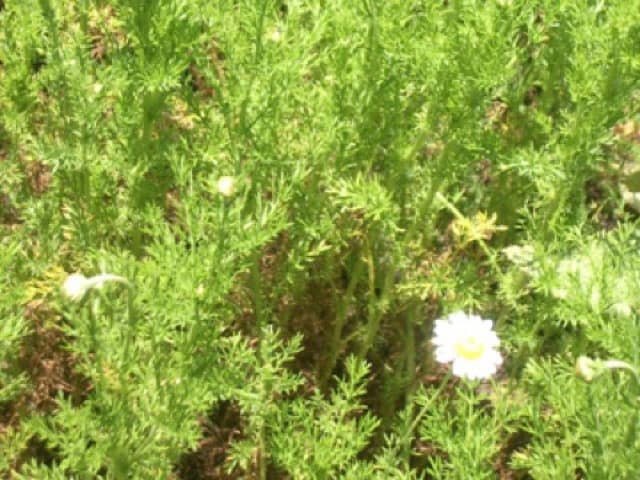Main menu
Common skin conditions

NEWS
Join DermNet PRO
Read more
Quick links
Chamomile — extra information
Chamomile
Author: Hon A/Prof Marius Rademaker, Dermatologist, Hamilton, New Zealand, 1999.
Common name: |
Sweet (Roman) chamomile, German chamomile |
Botanical name: |
Anthemis nobilis, Chamaemelum nobile, Matricaria chamomilla |
Family: |
Belong to the Asteraceae (compositae) family of plants. |
Origin: |
European. |
Description: |
25x40 cm ultra-hardy with finely cut pungent leaves, daisy-like white flowers in early to mid-summer. |


Uses: |
There are a number of plants called chamomile (see table). Sweet chamomile has been planted in lawns since the early Elizabethan times. The dried flowers are used to make chamomile tea. Oil from the flowers is said to help 'stitches and pains in the side' among many other uses. A proprietary cream (Kamillosan) is promoted for the prevention and treatment of nappy rash and as a nipple cream. |
Allergens: |
The allergens in chamomile include nobilin (Sweet chamomile) and desacetylmatricarin (German chamomile). Both are sesquiterpenes. |
Allergy: |
In a six-year study from Germany, 67 patients were found to be allergic to chamomile. In another very interesting study of massage in children with bad atopic eczema, the children were divided into two groups, one which received a nightly massage from their parents and a second group who received nightly massage with essential oils (aromatherapy). The results showed a significant improvement in eczema in the two groups of children following therapy, but there was no significant difference in improvement shown between the aromatherapy massage and massage only group. In fact, a number of the children went on to develop worsening of their eczema due to allergy to the essential oils, including chamomile. The available proprietary chamomile cream has also been reported to cause allergic dermatitis on a number of occasions. Eye washing with chamomile tea is a folk remedy used by some to treat conjunctivitis and other ocular reactions. Unfortunately, one study showed 7 hay fever patients suffered from major conjunctivitis (2 with lid angioedema after eye washing with chamomile tea. They were, interestingly, able to drink chamomile tea with no reactions. Anaphylaxis and death have also been reported following exposure to chamomile, although fortunately this appears to be relatively rare. |
Cross reactions: |
May cross-react with other Compositae (Asteraceae and anthemis) such as chrysanthemum. |
Other information: |
Sir Francis Drake is thought to have played bowls on a chamomile lawn on the eve of the armada. |
Patch test: |
Varieties of chamomile
Sweet (roman) chamomile |
Chamaemelum nobile |
European native, perennial. Source of chamomile tea. Allergenic |
Wild (german) chamomile |
Matricaria recutita |
An annual weed, allergenic |
Scentless mayweed |
Matricaria inodora |
A tall annual weed, allergenic |
Stinking mayweed (dog fennel) |
Anthemis cotula |
An annual weed, strongly irritant. Maybe allergenic |
Corn chamomile |
Anthemis arvensis |
Annual, sickly scented. Uncommon. Allergenic |
Yellow chamomile |
Anthemis tinctoria |
European biennial. Source of yellow dye. No reports of allergy |
References
- Paulsen E, Andersen KE, Hausen BM. Sensitization and cross-reaction patterns in Danish Compositae-allergic patients. Contact Dermatitis. 2001 Oct;45(4):197-204.
- Reider N, Sepp N, Fritsch P, Weinlich G, Jensen-Jarolim E. Anaphylaxis to camomile: clinical features and allergen cross-reactivity. Clin Exp Allergy 2000 Oct;30(10):1436-43.
- Anderson C, Lis-Balchin M, Kirk-Smith M. Evaluation of massage with essential oils on childhood atopic eczema. Phytother Res. 2000 Sep;14(6):452-6.
- Foti C, Nettis E, Panebianco R, Cassano N, Diaferio A, Pia DP. Contact urticaria from Matricaria chamomilla. Contact Dermatitis. 2000 Jun;42(6):360-1.
- Giordano-Labadie F, Schwarze HP, Bazex J. Allergic contact dermatitis from camomile used in phytotherapy. Contact Dermatitis. 2000 Apr;42(4):247.
- Rodriguez-Serna M, Sanchez-Motilla JM, Ramon R, Aliaga A. Allergic and systemic contact dermatitis from Matricaria chamomilla tea. Contact Dermatitis. 1998 Oct;39(4):192-3.
- Rudzki E, Rebandel P. Positive patch test with Kamillosan in a patient with hypersensitivity to camomile. Contact Dermatitis. 1998 Mar;38(3):164.
- Pereira F, Santos R, Pereira A. Contact dermatitis from chamomile tea. Contact Dermatitis. 1997 Jun;36(6):307.
- Hausen BM. A 6-year experience with compositae mix. Am J Contact Dermat. 1996 Jun;7(2):94-9.
- Bossuyt L, Dooms-Goossens A. Contact sensitivity to nettles and camomile in 'alternative' remedies. Contact Dermatitis. 1994 Aug;31(2):131-2.
- McGeorge BC, Steele MC. Allergic contact dermatitis of the nipple from Roman chamomile ointment. Contact Dermatitis. 1991 Feb;24(2):139-40.
- Subiza J, Subiza JL, Alonso M, Hinojosa M, Garcia R, Jerez M, Subiza E. Allergic conjunctivitis to chamomile tea. Ann Allergy. 1990 Aug;65(2):127-32.
- van Ketel WG. Allergy to Matricaria chamomilla. Contact Dermatitis. 1987 Jan;16(1):50-1.
- Lovell CR.1993, Plants and the Skin, Blackwell, Oxford.
- Mitchell JC, Rook A, 1979, Botanical Dermatology, Plants and Plant products injurious to the skin, Greengrass, Vancouver.
Other websites
- Chamomile – MedlinePlus
